Design Science Research Evaluation and Entrepreneurship Synergy Report
VerifiedAdded on 2023/06/08
|6
|945
|268
Report
AI Summary
This report provides summaries of two key articles related to IT innovation. The first article discusses a comprehensive framework for evaluation in design science research (DSR), emphasizing the purpose, nature of evaluands, design goals, and methodology. It highlights the importance of evaluation in authenticating ID design theories, identifying better artifacts, and formative evaluation to determine strengths and weaknesses. The second article explores the synergy between entrepreneurship and innovation, focusing on factors affecting their connections, commercialization of innovations, and the impact of organizational culture. It differentiates between entrepreneurs and small business owners, discusses innovation dimensions, and highlights the importance of managerial styles and skills for business growth. The report concludes with an integrated framework for applying innovation and entrepreneurship in business organizations.
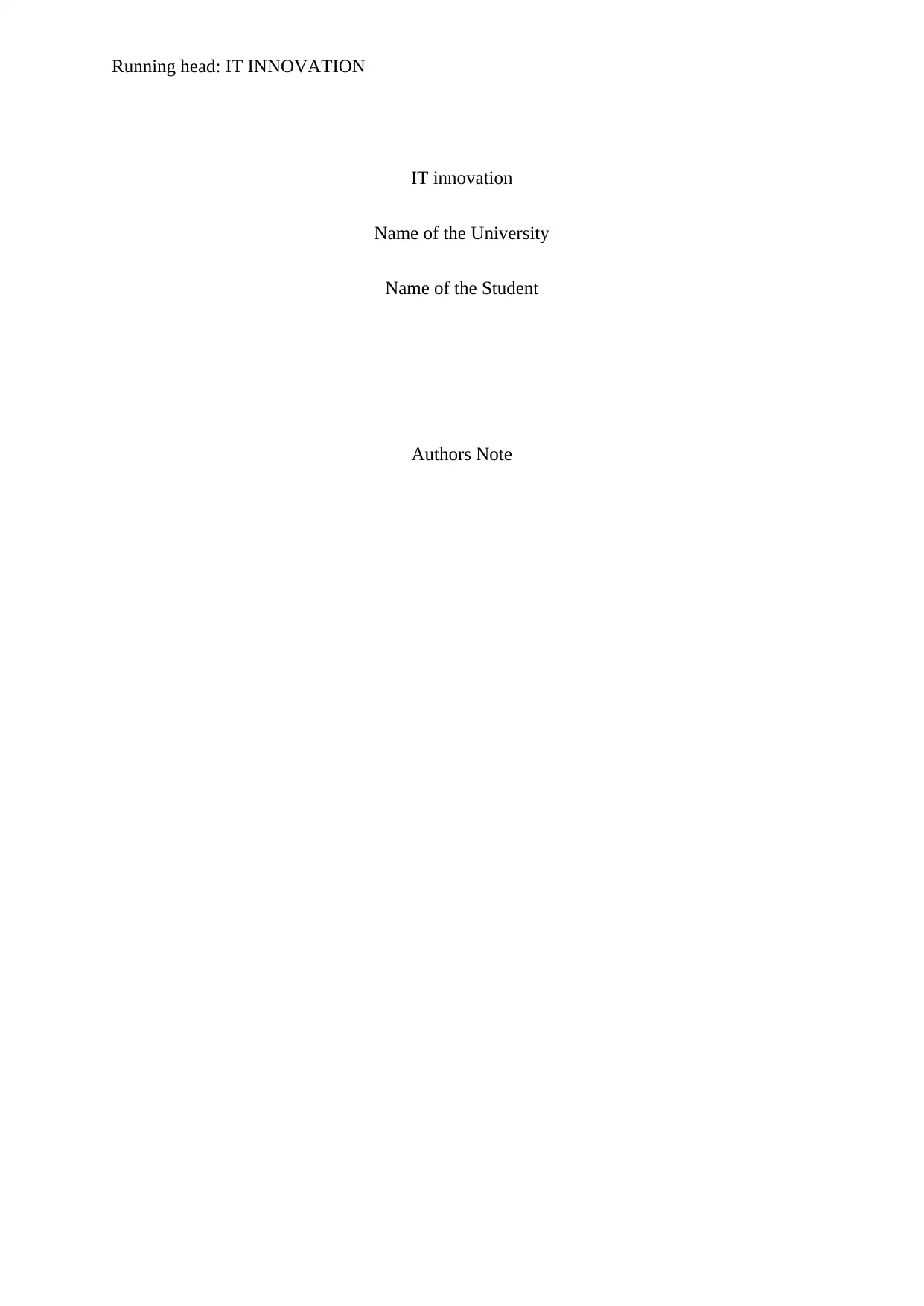
Running head: IT INNOVATION
IT innovation
Name of the University
Name of the Student
Authors Note
IT innovation
Name of the University
Name of the Student
Authors Note
Paraphrase This Document
Need a fresh take? Get an instant paraphrase of this document with our AI Paraphraser
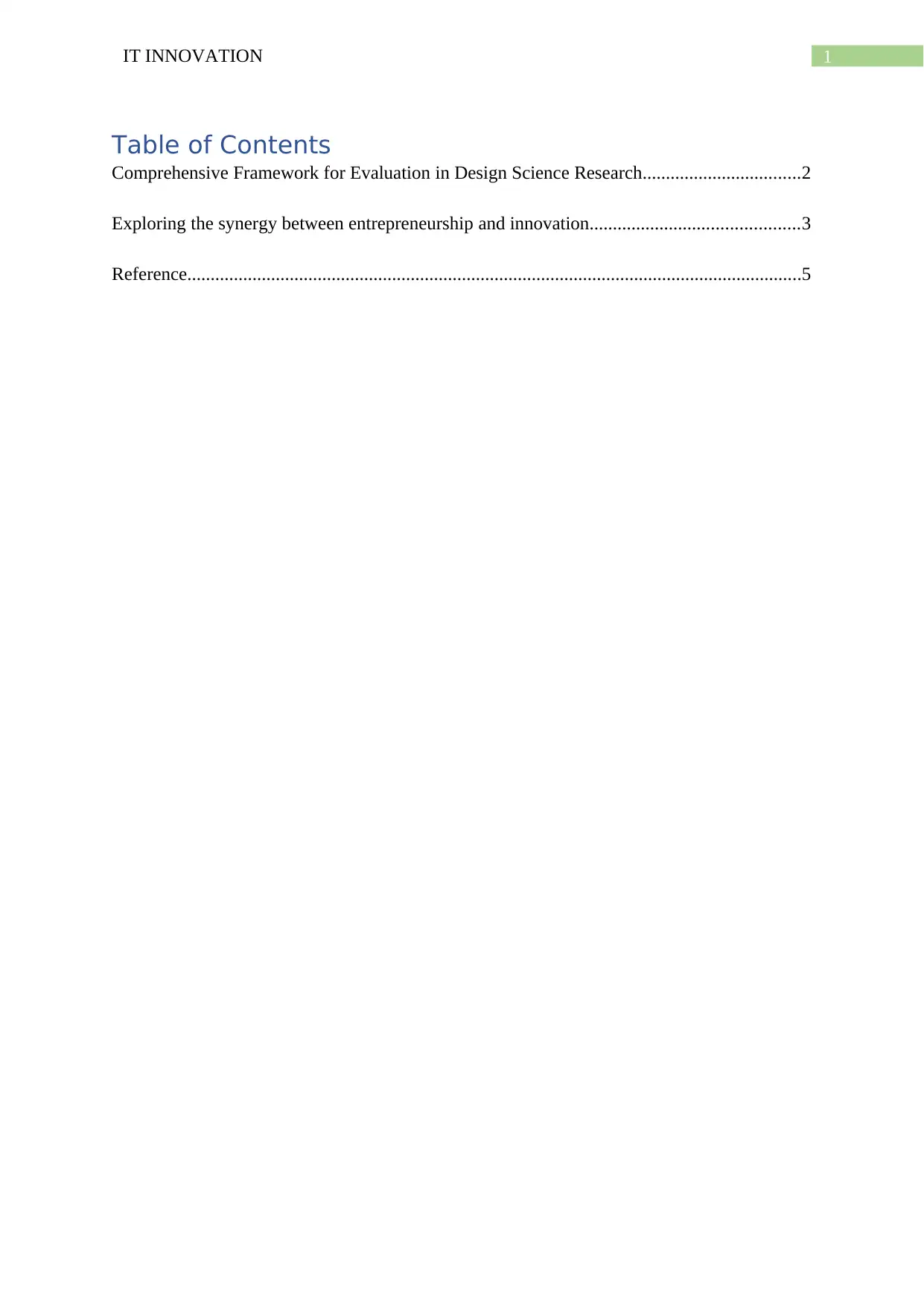
1IT INNOVATION
Table of Contents
Comprehensive Framework for Evaluation in Design Science Research..................................2
Exploring the synergy between entrepreneurship and innovation.............................................3
Reference....................................................................................................................................5
Table of Contents
Comprehensive Framework for Evaluation in Design Science Research..................................2
Exploring the synergy between entrepreneurship and innovation.............................................3
Reference....................................................................................................................................5
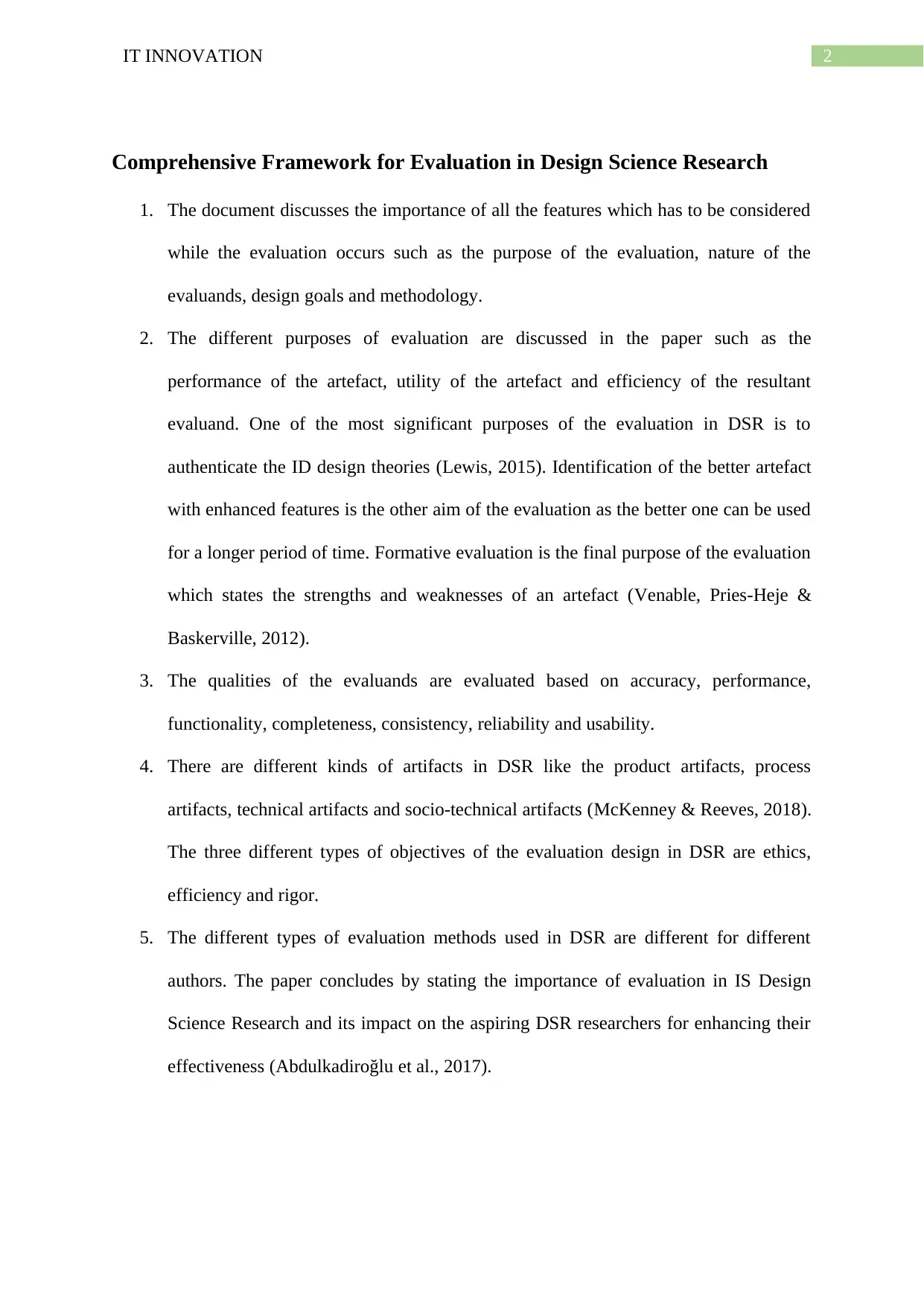
2IT INNOVATION
Comprehensive Framework for Evaluation in Design Science Research
1. The document discusses the importance of all the features which has to be considered
while the evaluation occurs such as the purpose of the evaluation, nature of the
evaluands, design goals and methodology.
2. The different purposes of evaluation are discussed in the paper such as the
performance of the artefact, utility of the artefact and efficiency of the resultant
evaluand. One of the most significant purposes of the evaluation in DSR is to
authenticate the ID design theories (Lewis, 2015). Identification of the better artefact
with enhanced features is the other aim of the evaluation as the better one can be used
for a longer period of time. Formative evaluation is the final purpose of the evaluation
which states the strengths and weaknesses of an artefact (Venable, Pries-Heje &
Baskerville, 2012).
3. The qualities of the evaluands are evaluated based on accuracy, performance,
functionality, completeness, consistency, reliability and usability.
4. There are different kinds of artifacts in DSR like the product artifacts, process
artifacts, technical artifacts and socio-technical artifacts (McKenney & Reeves, 2018).
The three different types of objectives of the evaluation design in DSR are ethics,
efficiency and rigor.
5. The different types of evaluation methods used in DSR are different for different
authors. The paper concludes by stating the importance of evaluation in IS Design
Science Research and its impact on the aspiring DSR researchers for enhancing their
effectiveness (Abdulkadiroğlu et al., 2017).
Comprehensive Framework for Evaluation in Design Science Research
1. The document discusses the importance of all the features which has to be considered
while the evaluation occurs such as the purpose of the evaluation, nature of the
evaluands, design goals and methodology.
2. The different purposes of evaluation are discussed in the paper such as the
performance of the artefact, utility of the artefact and efficiency of the resultant
evaluand. One of the most significant purposes of the evaluation in DSR is to
authenticate the ID design theories (Lewis, 2015). Identification of the better artefact
with enhanced features is the other aim of the evaluation as the better one can be used
for a longer period of time. Formative evaluation is the final purpose of the evaluation
which states the strengths and weaknesses of an artefact (Venable, Pries-Heje &
Baskerville, 2012).
3. The qualities of the evaluands are evaluated based on accuracy, performance,
functionality, completeness, consistency, reliability and usability.
4. There are different kinds of artifacts in DSR like the product artifacts, process
artifacts, technical artifacts and socio-technical artifacts (McKenney & Reeves, 2018).
The three different types of objectives of the evaluation design in DSR are ethics,
efficiency and rigor.
5. The different types of evaluation methods used in DSR are different for different
authors. The paper concludes by stating the importance of evaluation in IS Design
Science Research and its impact on the aspiring DSR researchers for enhancing their
effectiveness (Abdulkadiroğlu et al., 2017).
⊘ This is a preview!⊘
Do you want full access?
Subscribe today to unlock all pages.

Trusted by 1+ million students worldwide

3IT INNOVATION
Exploring the synergy between entrepreneurship and innovation
1. This paper discusses the combination of the entrepreneurship and innovation in the
dynamic environment for accomplishing organisational sustainability (Chatterji,
Glaeser & Kerr, 2014). The paper develops an integrative agenda of the collaboration
between innovation and entrepreneurship.
2. The paper discusses the factors affecting the connections between innovation and
entrepreneurship and what effect does it have on the commercialisation of
innovations.
3. The paper discusses the key elements of entrepreneurship which are proactivity,
innovation and risk taking, but these elements are subjected to changes according to
the situation (Galindo & Méndez, 2014).
4. The paper focuses on the difference between the entrepreneurs and the small business
owners and discusses the similarities between the entrepreneurship and corporate
entrepreneurship and intrapreneurship.
5. The innovation dimensions are product vs. process, administrative vs. technological
and radical vs. incremental.
6. The article also highlights the cultural issues which have an impact on the innovation
and entrepreneurship.
7. Based on this article it can be stated that innovation is the foundation of the
entrepreneurship and both are related to each other. An entrepreneur uses innovation
to enhance their business (Sahut & Peris-Ortiz, 2014). A good organisational culture
and effective management style is required for successful commercialisation of
innovation.
8. The different types of issues related to the application of innovation and
entrepreneurship in business organisations are highlighted in the later stages of the
Exploring the synergy between entrepreneurship and innovation
1. This paper discusses the combination of the entrepreneurship and innovation in the
dynamic environment for accomplishing organisational sustainability (Chatterji,
Glaeser & Kerr, 2014). The paper develops an integrative agenda of the collaboration
between innovation and entrepreneurship.
2. The paper discusses the factors affecting the connections between innovation and
entrepreneurship and what effect does it have on the commercialisation of
innovations.
3. The paper discusses the key elements of entrepreneurship which are proactivity,
innovation and risk taking, but these elements are subjected to changes according to
the situation (Galindo & Méndez, 2014).
4. The paper focuses on the difference between the entrepreneurs and the small business
owners and discusses the similarities between the entrepreneurship and corporate
entrepreneurship and intrapreneurship.
5. The innovation dimensions are product vs. process, administrative vs. technological
and radical vs. incremental.
6. The article also highlights the cultural issues which have an impact on the innovation
and entrepreneurship.
7. Based on this article it can be stated that innovation is the foundation of the
entrepreneurship and both are related to each other. An entrepreneur uses innovation
to enhance their business (Sahut & Peris-Ortiz, 2014). A good organisational culture
and effective management style is required for successful commercialisation of
innovation.
8. The different types of issues related to the application of innovation and
entrepreneurship in business organisations are highlighted in the later stages of the
Paraphrase This Document
Need a fresh take? Get an instant paraphrase of this document with our AI Paraphraser
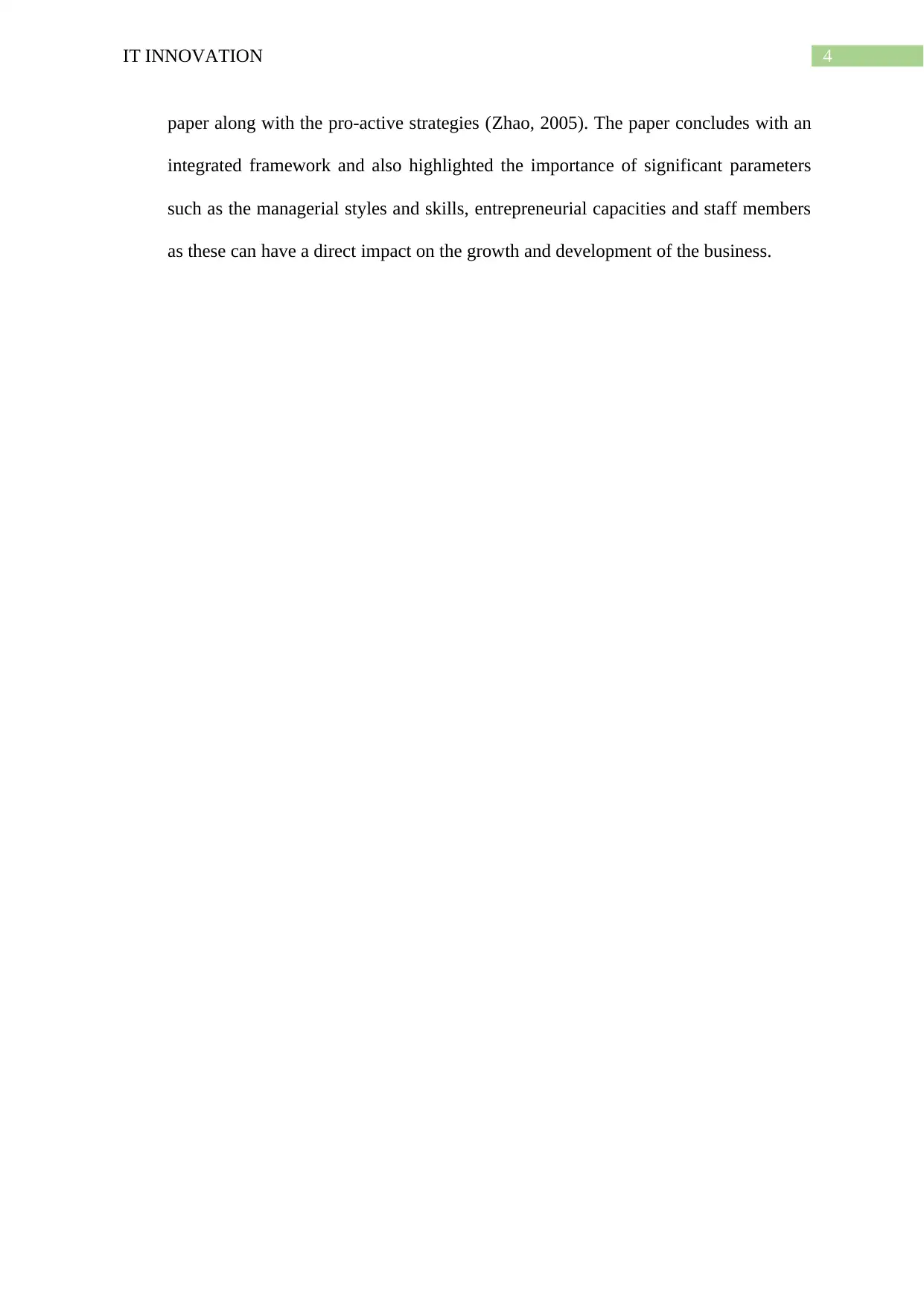
4IT INNOVATION
paper along with the pro-active strategies (Zhao, 2005). The paper concludes with an
integrated framework and also highlighted the importance of significant parameters
such as the managerial styles and skills, entrepreneurial capacities and staff members
as these can have a direct impact on the growth and development of the business.
paper along with the pro-active strategies (Zhao, 2005). The paper concludes with an
integrated framework and also highlighted the importance of significant parameters
such as the managerial styles and skills, entrepreneurial capacities and staff members
as these can have a direct impact on the growth and development of the business.
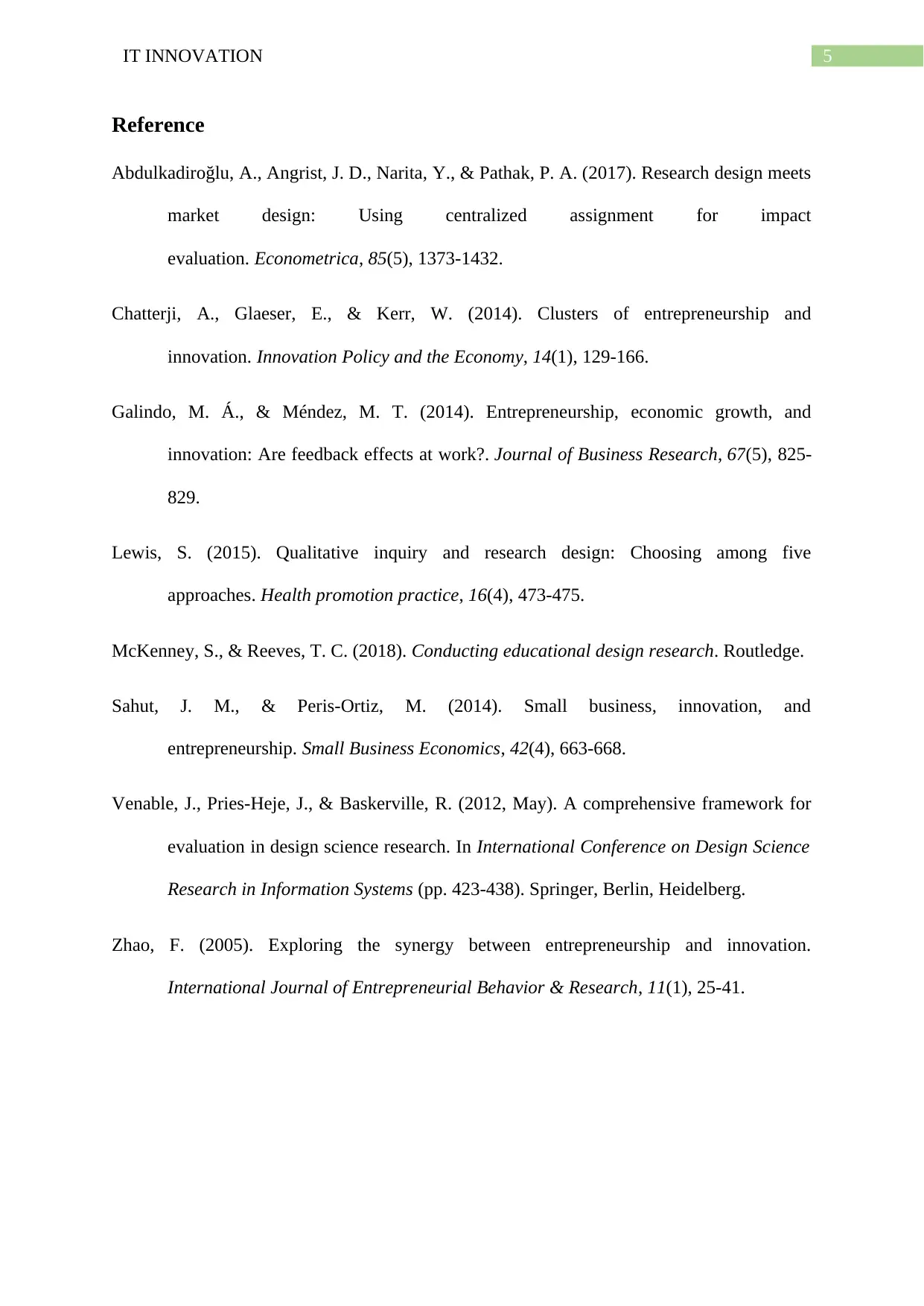
5IT INNOVATION
Reference
Abdulkadiroğlu, A., Angrist, J. D., Narita, Y., & Pathak, P. A. (2017). Research design meets
market design: Using centralized assignment for impact
evaluation. Econometrica, 85(5), 1373-1432.
Chatterji, A., Glaeser, E., & Kerr, W. (2014). Clusters of entrepreneurship and
innovation. Innovation Policy and the Economy, 14(1), 129-166.
Galindo, M. Á., & Méndez, M. T. (2014). Entrepreneurship, economic growth, and
innovation: Are feedback effects at work?. Journal of Business Research, 67(5), 825-
829.
Lewis, S. (2015). Qualitative inquiry and research design: Choosing among five
approaches. Health promotion practice, 16(4), 473-475.
McKenney, S., & Reeves, T. C. (2018). Conducting educational design research. Routledge.
Sahut, J. M., & Peris-Ortiz, M. (2014). Small business, innovation, and
entrepreneurship. Small Business Economics, 42(4), 663-668.
Venable, J., Pries-Heje, J., & Baskerville, R. (2012, May). A comprehensive framework for
evaluation in design science research. In International Conference on Design Science
Research in Information Systems (pp. 423-438). Springer, Berlin, Heidelberg.
Zhao, F. (2005). Exploring the synergy between entrepreneurship and innovation.
International Journal of Entrepreneurial Behavior & Research, 11(1), 25-41.
Reference
Abdulkadiroğlu, A., Angrist, J. D., Narita, Y., & Pathak, P. A. (2017). Research design meets
market design: Using centralized assignment for impact
evaluation. Econometrica, 85(5), 1373-1432.
Chatterji, A., Glaeser, E., & Kerr, W. (2014). Clusters of entrepreneurship and
innovation. Innovation Policy and the Economy, 14(1), 129-166.
Galindo, M. Á., & Méndez, M. T. (2014). Entrepreneurship, economic growth, and
innovation: Are feedback effects at work?. Journal of Business Research, 67(5), 825-
829.
Lewis, S. (2015). Qualitative inquiry and research design: Choosing among five
approaches. Health promotion practice, 16(4), 473-475.
McKenney, S., & Reeves, T. C. (2018). Conducting educational design research. Routledge.
Sahut, J. M., & Peris-Ortiz, M. (2014). Small business, innovation, and
entrepreneurship. Small Business Economics, 42(4), 663-668.
Venable, J., Pries-Heje, J., & Baskerville, R. (2012, May). A comprehensive framework for
evaluation in design science research. In International Conference on Design Science
Research in Information Systems (pp. 423-438). Springer, Berlin, Heidelberg.
Zhao, F. (2005). Exploring the synergy between entrepreneurship and innovation.
International Journal of Entrepreneurial Behavior & Research, 11(1), 25-41.
⊘ This is a preview!⊘
Do you want full access?
Subscribe today to unlock all pages.

Trusted by 1+ million students worldwide
1 out of 6
Related Documents
Your All-in-One AI-Powered Toolkit for Academic Success.
+13062052269
info@desklib.com
Available 24*7 on WhatsApp / Email
![[object Object]](/_next/static/media/star-bottom.7253800d.svg)
Unlock your academic potential
Copyright © 2020–2025 A2Z Services. All Rights Reserved. Developed and managed by ZUCOL.




